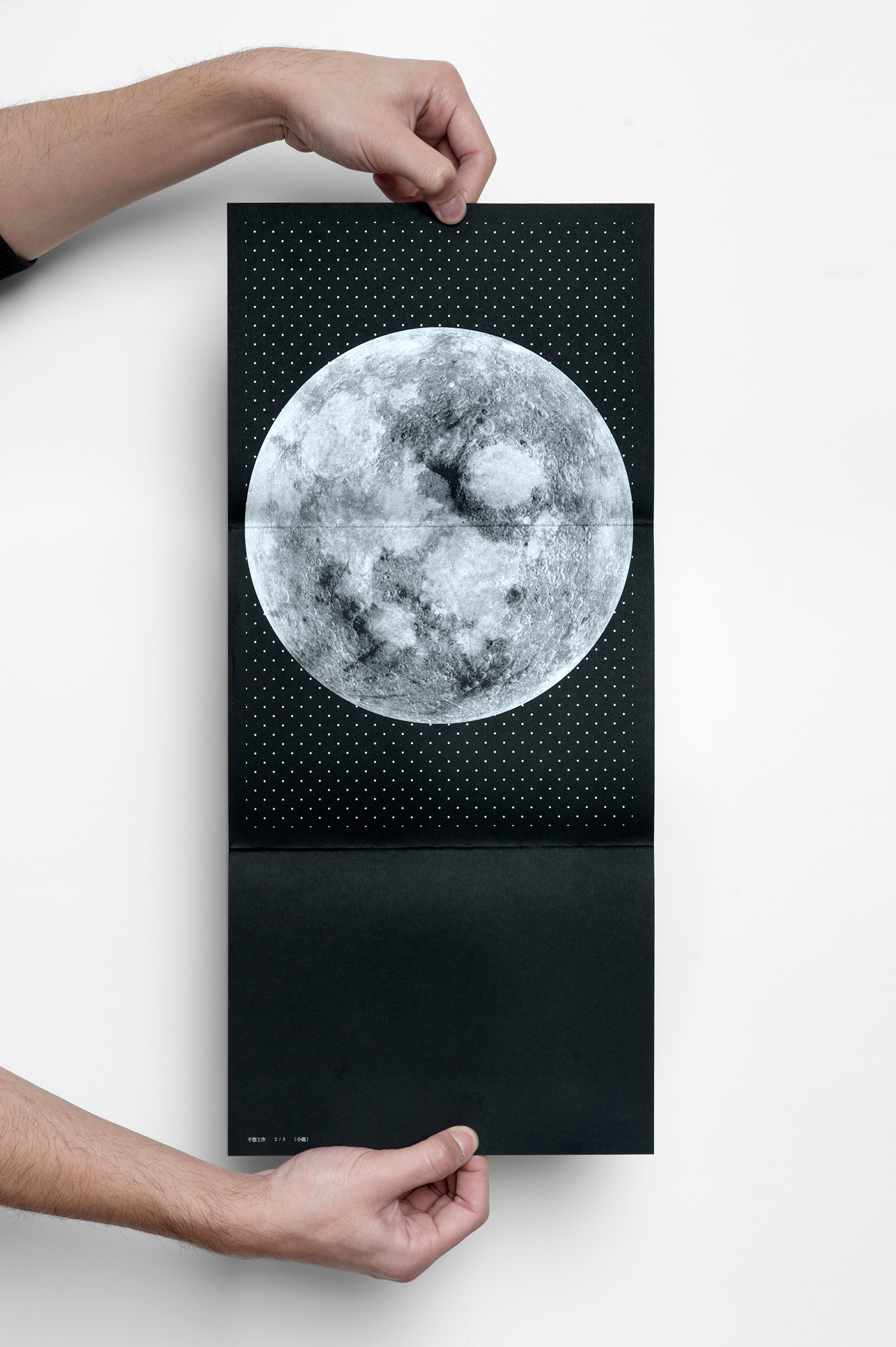












Title / 不想工作 / Nagging (Don’t Wanna Work) : Chinese-English Bilingual Edition
Text / 彭星凱 / Fi Peng | Photograph / 高啟舜 / Kyle Kao | Translation / 李彥儀 / Yen-Yi Lee
Design / 空白地區 workshop | Publish / Black Issue - NST Design Co., Ltd.
Text / 彭星凱 / Fi Peng | Photograph / 高啟舜 / Kyle Kao | Translation / 李彥儀 / Yen-Yi Lee
Design / 空白地區 workshop | Publish / Black Issue - NST Design Co., Ltd.
2014 Golden Butterfly Awards - Bronze Award, the winner of the iF Design Award
Oct 21, 2O13.自序
作家周芬伶在她的著作《散文課》裡提到,好的散文應建立在美好體驗之上。而我自認為是個生活貧乏的人,只好盡力將普通體驗寫得美好。《不想工作》是由兩年來我於社群網站私密發佈的二十一首散文詩作所集結成冊,從最初蒐集的兩萬字精節至目前的六千,將一些更百無聊賴、不具收藏價值的娛樂性內容刪去(可能大家比較想看這個?),只留下文字最精緻完整的表情。
全書以海報形式作為出版品發表,初衷在挑戰「書為何必須成冊」的出版框架,以及嘗試做出符合消費市場品味的獨立刊物,並提醒台灣環境海報文化存在的意義與價值。在過去幾次協助或親身執行策展的經驗裡,我體認在台灣想要張貼海報是極其困難的,而大部份的品牌或團體,則如同將海報比擬傳單,放上數百字的概念介紹、演出日期、購票資訊、地點⋯⋯,但即便能夠順利被張貼,也只有三到五秒被記憶的機會,所以海報理當是個需要被精簡至極端、功能僅止於初步提醒或誘發觀者興致的媒體。(我真希望讀者將《不想工作》貼在辦公室的牆上啊)
另一方面,我也嘗試於平面傳達網路「線性呈現」(一次展開所有資訊)卻「非線性閱讀」(使用者跳躍式瀏覽喜好內容)的編整邏輯。海報一如社群網站的塗鴉墻,今天打開看到哪裡,就從哪裡開始讀。《不想工作》是在一種必須在工作狀態下才得以成立的身不由己、一種常態的呢喃、自知安逸於現況卻無法嘗試脫身的奢侈焦慮。它存在於我們每個人心中的一角,是我們得以發生共鳴的最佳契機。
隨書附贈的影像別冊《我突然覺得好多了》,邀請已有十年交情的攝影師高啟舜,詮釋文字到影像的性格轉化。這個「轉化」並非可供對照的插圖邏輯,而是某種情緒與感官的定調。在視覺的磨合過程中,我們發現成功的攝影多將感情留在被攝者,而攝影師則必須作一個客觀的記錄員,抽離自我溢滿的見解與熱情,躲藏在鏡頭背後──雖然如此結論很可能是主觀的,至少我們都從這裡學習到如何收斂狂妄,如何回歸本質。
踏入社會初期我迷戀於中興百貨、誠品的廣告文案,近年接觸出版圈,受朱天心、駱以軍、丁名慶等華文作家影響,學習如何洗煉的用字、如何讓書寫後的被想像更加優雅而銳利。過去由廣告語言培養的節奏仍參雜其中,常寫了一段就得唸上數十遍,確定文字的銜接沒有累贅了才敢發佈(即使將看到的人寥寥可數)。若真要說起來,我想也是某種星座性格操控下的潔癖再現吧。
如果設計對我來說是事業成就上的表徵;書寫就是結構精神狀態、誠實面對自我外在與內裡的唯一途徑。也或許這便是我做了但沒說清楚的:在「不想工作」之後,你會搞些什麼名堂?
Oct 21, 2013. Introduction
The author, Fen-Ling Zhou, mentioned in her book Prose Lessons that a fine piece of writing shall have beautiful experiences as its ground. Since my own life as a rather mundane one, I tried my best making these ordinary experiences somehow better in writing. Nagging is a collection of twenty-one prose poems that I published on my private social network platform in recent two years. Initially, 20,000 words were collected and then filtered until the 6000 words now; some of the rather blunted, with less collecting values entertainment content took out from this edition (perhaps it’s the part that most of people actually interested in ?), only the most refined one with wholesome expression writing pieces were kept in this book.
The book was published in the poster format. The initial goal was to challenge the publishing ideology of ‘Why has books always have always to be bound together’, and try to achieving market fit as an independent publication, meanwhile reminding others that the value and meaning of the poster culture in Taiwan. In my past curating experiences, both assisting and as a chief curator, in which I learnt the difficulties to put up a poster in Taiwan. Most of the brands and firms tend to think posters and flyers as the same thing, therefore they cramped in the poster with hundreds of introductory words, event dates, ticket information, location ......etc. Even if the posters went on walls successfully, it only gets a chance to be remembered within 3-5 seconds. Therefore, posters are suppose to be a medium that is simplified to its utmost, and shall only function as a preliminary reminder or for attracting viewers’ attention.
On the other hand, I also try to put on the editorial logic: the liner representation of the Internet (ex: expand all the information at the same time) yet the non-liner reading path (Users will pick and choose what they tend to browse according to their preferences). Posters as the Wall of social network that one starts to read from where they lay their eyes at the moment when the pages spread open. Nagging (Book title for Chinese edition literal translated as Don’t wanna work) an involuntary condition that only happens when one is at work: regularly mumbling, being self aware the current comfort condition yet still fussing about the anxiety of unable to get away from it. It exists at the very corner of our hearts, and it is the right timing that makes us all click.
The additional visual edition I Think I’m Much Better Now which is published along with the book features the photographer, Kyle Kuo, who I have known for about ten years, to portray the character transformation from writing to visual imageries. This ‘Transformation’ isn’t the same logic applies to illustration but the pitch of a certain emotion or sensor. During the process of molding with visual imagery, we realized that a piece of successful photographical work that usually let along the emotion resides within its subject, and the photographer plays the role as an objective recorder- one detaches from one‘s own complacent opinion and passion, hiding behind the camera lens- although the tempt to conclude the scenario as such could be very subjective, but we at least get to learn how to restraint the arrogance in order to be back to the basic.
At the first stage of entering the workforce, I was obsessed with the copywriting of Sunrise Department Store, Eslite Bookstore. With the influences from Tian-Xin Zhu, Yi-Jun Luo, Ming-Ching Ding and other mandarin writer during my association with the publishing industry in recent years. Learning how to choose the precise wording and how to elevate the imagination of what had been written down in a more elegant and poignant level. The trace of copywriting training can still be seen within the text, often it needs to be read over and over again after each paragraph was written in order to reassure all the prolix wordings between the threads of each words were eliminated before publicizing it (Even only very few people will see.) Technically speaking, it might be a mysophobia representation of some dominating character of a certain horoscope I reckon.
If design is the signifier of the career remark for me, writing is the only path that constructs my mind state and which gives me an honest confrontation with the external and internal self. It may be the thing that I did but failed to offer a clear explanation: What other tricks will you play outside of Nagging?







